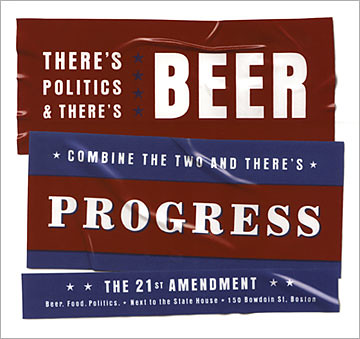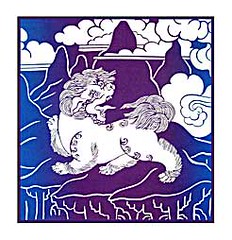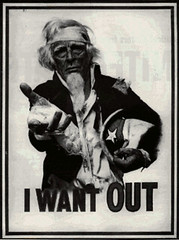 This has been a pretty demoralizing day for blogging. In fact, the more I do this, the more I see a resemblance to television, where serious, important information and artistic expression consistently loses in the ratings to drecky fluff like "The Apprentice" and sado-tittilations like "Fear Factor". You post a piece you put your heart and soul into, maybe you spent hours getting it just right and running down all the links and verifications, and it falls on its face like a drunken ape on rollerskates. But put up a picture of a pussycat, or tell a goofy joke, and the response can be immediate and overwhelming. I'm still getting hits on a post I did months ago which was nothing more than a couple of sentences bitching about Caitlin Flanagan done in a rum-soaked funk. I know, I know, there are some wonderful writers blogging who are also appreciated--just like you get the occasional "Oz" or "Seinfeld" on TV--but face it, they're in the minority. I know I'm puking self-pity here, but so what? Hardly anyone will see it, and I can soothe myself with the knowledge that I can say anything I want, barring some kind of Treasury Department bot-sweep on the lookout for insults to the Dauphin.
This has been a pretty demoralizing day for blogging. In fact, the more I do this, the more I see a resemblance to television, where serious, important information and artistic expression consistently loses in the ratings to drecky fluff like "The Apprentice" and sado-tittilations like "Fear Factor". You post a piece you put your heart and soul into, maybe you spent hours getting it just right and running down all the links and verifications, and it falls on its face like a drunken ape on rollerskates. But put up a picture of a pussycat, or tell a goofy joke, and the response can be immediate and overwhelming. I'm still getting hits on a post I did months ago which was nothing more than a couple of sentences bitching about Caitlin Flanagan done in a rum-soaked funk. I know, I know, there are some wonderful writers blogging who are also appreciated--just like you get the occasional "Oz" or "Seinfeld" on TV--but face it, they're in the minority. I know I'm puking self-pity here, but so what? Hardly anyone will see it, and I can soothe myself with the knowledge that I can say anything I want, barring some kind of Treasury Department bot-sweep on the lookout for insults to the Dauphin.So tonight I'm posting something suitably content-free and lightweight: the fate of beer. At Slate, in an article subtitled "the great American beer crisis" we read these doleful reports:
“Last week, two leading beer companies reported disappointing results. Anheuser-Busch, which claims more than half the U.S. beer market, announced it was suffering from falling demand and rising costs. The volume of Bud and Michelob sold in the U.S. fell 2.7 percent from the year-ago quarter. Newly merged cross-border beer powerhouse Molson Coors reported a loss, with net sales in the U.S. down 2 percent, and U.S. operating income off by nearly one-third. The most recent trading statement of Miller, the No. 2 U.S. beer brand now owned by SABMiller, showed marginal growth.”Dire times, indeed. And made all the more mystifying by the veritable blanket of advertising the megamarkets have smothered us with these last few years, most of which seems to consist of trying to get the beer drinking public to identify with coozy blonde hormone grenades and mouth-breathing overgrown prepubescents engaging in stunts so imbecilic that it would take a self-loathing bordering on suicidal to identify with them. Setting aside the not inconsiderable matter of the taste of the bear-whiz they're selling, who wouldn't want to be cajoled into hoisting a Bud or a Miller by being told one will join the ranks of the moronic in doing so?
The article goes on to blame yuppification--thin, snotty left coasters, roly-poly 50-somethings, Village types in black, the joie de vivre crowd--for turning the thirsty American herds to the more delicate and sophisticated joys of wine and liquor:
"The real problem is that Americans increasingly tipple with wine and hard liquor. Health-conscious baby-boomers, fretting about waistlines and heart murmurs, are eschewing high-carb beer for cardiac-friendly merlot (or, post-Sideways, pinot noir). According to the Wine Institute, U.S. wine sales have risen smartly in recent years, from 558 million gallons in 2000 to 627 million gallons in 2003. Meanwhile, the young and hip—traditionally the biggest consumers of beer—are looking for harder stuff. Club-goers want less Molson Ice and more Maker's Mark. The spirits crowd has become better at marketing, too, especially to younger consumers."Not much mention of the low-carb craze (which I'm guessing has probably hit beer-makers like it has bread-bakers), but more important, no mention of the incredible growth of microbrews and home brewing over the last 20 years. This is a "fad" that has transformed the beer drinking landscape, for those of us who merely drink, and those of us who also brew. Brewpubs are fast becoming a staple in large and medium-sized cities and environs, and beer styles have grown enormously. CNN was on top of it last year:
“There are now more than 1,400 craft breweries in the United States. Nearly 1,000 of those are brewpubs (restaurants that make their own beer), with 440 microbreweries and regional specialty breweries.It’s not that people aren’t drinking beer…it’s that they have become educated about what real beer should taste like, and are putting their money where their mouths are, so to speak. Even the megamarketers are acknowledging it--Bud started selling Michelob Amber Bock in 1995, and went into partnership with Seattle's Redhook micro in 1994. Miller bought up and made a subsidiary of the Jacob Leinenkugel Brewing Co, which makes and sells weisses and bocks.
Sales volumes of beer made by the majors grew by 1.6 percent last year, and imports rose by 2 percent. Craft brewers, however, rose by 5 percent.
"Beer drinkers are changing their tastes," says Gatza. "They have much less loyalty to individual brands than they once did. They're more willing to experiment with different beers and styles."
Indeed, every region of the country now boasts one or more strong local microbreweries, capturing shelf space at stores and appearing on tap handles at bars and restaurants.”
So I wouldn't bemoan the death of beer just yet. But I have to admit that watching a year's worth of Coors Lite being shot toward the sun in order to make room at the tap for a Victory Hop Devil would be my kind of funeral pyre.





No comments:
Post a Comment